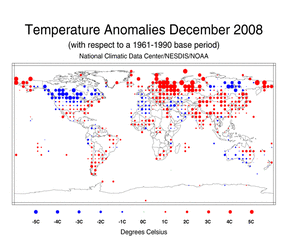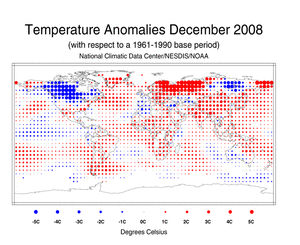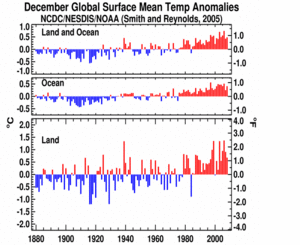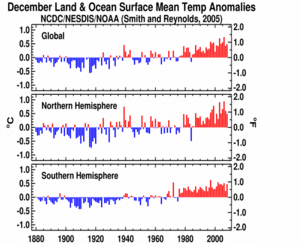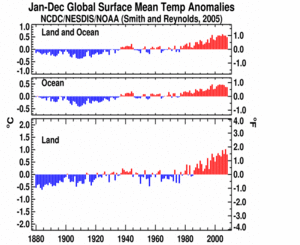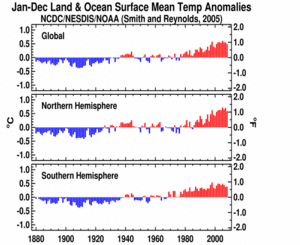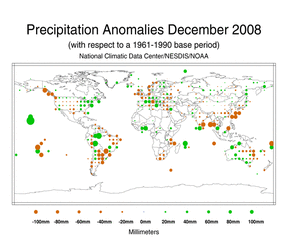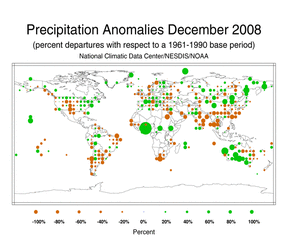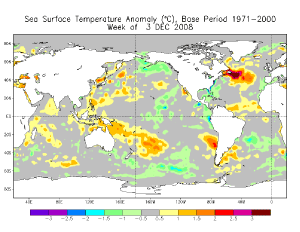Global Highlights:
- Based on preliminary data, the globally averaged combined land and sea surface temperature was the eighth warmest on record for December and the January-December period.
- December 2008 temperatures were above average in Iceland, Fenno-Scandinavia, western and eastern Russia, western Alaska, the eastern contiguous U.S., western and southeastern Africa, eastern Europe, western Australia, and most of Mexico, South America, and southern and southeastern Asia. Meanwhile, cooler-than-average conditions were present across Canada, the north-central and northwestern continental U.S., central Russia, western Europe, western and southern Australia, and parts of the Middle East Region.
- Precipitation during December 2008 was variable in many areas. In general, precipitation was above average in the Hawaiian Islands, the eastern continental U.S., western Australia, and across parts of South America and central Europe. Drier-than-average conditions were observed across the south-central contiguous U.S., Alaska's panhandle, eastern Australia, southeastern Africa, and most of South America, Europe, and southeastern Asia.
- Neutral phase El Niño-Southern Oscillation (ENSO) conditions persisted across the equatorial Pacific Ocean, although characteristics of a developing La Niña were present.
Contents of this Section:
The data presented in this report are preliminary. Ranks and anomalies may change as more complete data are received and processed. The most current data may be accessed via the Global Surface Temperature Anomalies page.
Introduction
Temperature anomalies for December 2008 are shown on the dot maps below. The dot map, below left, provides a spatial representation of anomalies calculated from the Global Historical Climatology Network (GHCN) data set of land surface stations using a 1961-1990 base period. The dot map, below right, is a product of a merged land surface and sea surface temperature anomaly analysis developed by Smith and Reynolds (2005). Temperature anomalies with respect to the 1961-1990 mean for land and ocean are analyzed separately and then merged to form the global analysis. Additional information on this product is available.
During December, anomalous warm conditions were present over much of the world's land surface, especially across Fenno-Scandinavia, western and eastern Russia, and western Alaska, where temperatures were 2°-6°C (4°-11°F) above the 1961-1990 mean. Above average temperatures were also observed across Iceland, the eastern contiguous U.S., western and southeastern Africa, eastern Europe, western Australia, and most of Mexico, South America, and southern and southeastern Asia. Elsewhere, cooler-than-average conditions were present across Canada, the north-central and northwestern continental U.S., central Russia, western Europe, western and southern Australia, and parts of the Middle East Region.
Sea surface temperatures (SST) during December 2008 were warmer than average across much of the Atlantic, Indian, and northwestern Pacific oceans. Cooler-than-average SSTs were present in parts of the southern oceans, the equatorial and northeastern Pacific Ocean, and parts of the Atlantic and Indian oceans. SST anomalies decreased in all Niño regions during December 2008, however neutral ENSO conditions persisted. Please see the December 2008 ENSO discussion for additional information.
Anomalously warm temperatures covered much of the world's land surface during January-December 2008. The year-to-date map shows the presence of warmer-than-average temperatures across all land areas, with the exception of Colombia, parts of Alaska, central Canada, and the midwestern continental U.S. Warmer-than-average SST conditions were present in the Atlantic and Indian oceans, and across parts of the Pacific oceans. Cooler-than-average conditions were observed in the central equatorial and northeastern Pacific oceans and parts of the southern oceans.
The mean position of the upper-level ridges of high pressure and troughs of low pressure (depicted by positive and negative 500-millibar height anomalies on the December map, respectively) are generally reflected by areas of positive and negative temperature anomalies at the surface, respectively. For other Global products, please see the Climate Monitoring Global Products page.
Images of sea surface temperature conditions are available for all weeks during 2008 at the weekly SST page.
Temperature Rankings and Graphics
Effective with the February 2006 report, NCDC transitioned from the use of the Operational Global Surface Temperature Index (Quayle et al. 1999) to the blended land and ocean dataset developed by Smith and Reynolds (2005). The differences between the two methods are discussed in Smith et al. (2005). The ranks found in the tables below are based on records that began in 1880.
The combined global land and ocean surface temperature was the eighth warmest on record in December and for the January-December period. The global average ocean SST in December tied with 2001 and 2005 as the sixth warmest on record.
| December | Anomaly | Rank (out of 129 years) |
Warmest (or Next Warmest) Year on Record |
|---|---|---|---|
GlobalLandOcean Land and Ocean |
+0.68°C (+1.22°F) +0.41°C (+0.74°F) +0.48°C (+0.86°F) |
14thwarmest 6th warmest 8th warmest |
2006 (+1.37°C/2.47°F) 1997 (+0.56°C/1.01°F) 2006 (+0.74°C/1.33°F) |
Northern HemisphereLandOcean Land and Ocean |
+0.69°C (+1.24°F) +0.37°C (+0.67°F) +0.49°C (+0.88°F) |
19th warmest 8th warmest 11th warmest |
1939 (+1.82°C/3.28°F) 2006 (+0.55°C/0.99°F) 2006 (+0.95°C/1.71°F) |
Southern HemisphereLandOcean Land and Ocean |
+0.62°C (+1.12°F) +0.45°C (+0.81°F) +0.47°C (+0.85°F) |
7th warmest 5th warmest 6th warmest |
1972 (+0.79°C/1.42°F) 1997 (+0.60°C/1.08°F) 1997 (+0.62°C/1.12°F) |
| January- December |
Anomaly | Rank (out of 129 years) |
Warmest Year on Record |
|---|---|---|---|
GlobalLandOcean Land and Ocean |
+0.81°C (+1.46°F) +0.37°C (+0.67°F) +0.49°C (+0.88°F) |
6thwarmest 10th warmest 8th warmest |
2007 (+1.02°C/1.84°F) 2003 (+0.48°C/0.86°F) 2005 (+0.61°C/1.10°F) |
Northern HemisphereLandOcean Land and Ocean |
+0.89°C (+1.60°F) +0.40°C (+0.72°F) +0.59°C (+1.06°F) |
5th warmest 9th warmest 8th warmest |
2007 (+1.18°C/2.12°F) 2005 (+0.54°C/0.97°F) 2005 (+0.72°C/1.30°F) |
Southern HemisphereLandOcean Land and Ocean |
+0.54°C (+0.97°F) +0.35°C (+0.63°F) +0.38°C (+0.68°F) |
6th warmest 10th warmest 9th warmest |
2005 (+0.81°C/1.46°F) 1998 (+0.50°C/0.90°F) 1998 (+0.53°C/0.95°F) |
The most current data may be accessed via the Global Surface Temperature Anomalies page.
Precipitation
The maps below represent anomaly values based on the GHCN data set of land surface stations using a base period of 1961-1990. Precipitation during December 2008 was above average over areas that include the Hawaiian Islands, the eastern continental U.S., western Australia, and across parts of South America and central Europe. Drier-than-average conditions were observed across the south-central contiguous U.S., Alaska's panhandle, eastern Australia, southeastern Africa, and most of South America, Europe, and southeastern Asia.
Details on flooding and drought can also be found on the December Global Hazards page.
ENSO SST Analysis
As shown in the adjacent animation, SST anomalies decreased across all Niño regions during December 2008. Although characteristics of a developing La Niña were present, neutral phase ENSO conditions remained across the equatorial Pacific Ocean. A comprehensive summary of December 2008 ENSO conditions can be found on the ENSO monitoring page. For the latest advisory on ENSO conditions go to NOAA's Climate Prediction Center (CPC) and the CPC ENSO Diagnostic Discussion.
Images of sea surface temperature conditions are available for all weeks since 2003 at the weekly SST page.
References
Peterson, T.C. and R.S. Vose, 1997: An Overview of the Global Historical Climatology Network Database. Bull. Amer. Meteorol. Soc., 78, 2837-2849.
Quayle, R.G., T.C. Peterson, A.N. Basist, and C. S. Godfrey, 1999: An operational near-real-time global temperature index. Geophys. Res. Lett., 26, 333-335.
Smith, T.M., and R.W. Reynolds (2005), A global merged land air and sea surface temperature reconstruction based on historical observations (1880-1997), J. Clim., 18, 2021-2036.
 NOAA's National Centers for Environmental Information
NOAA's National Centers for Environmental Information
